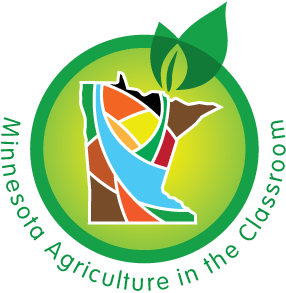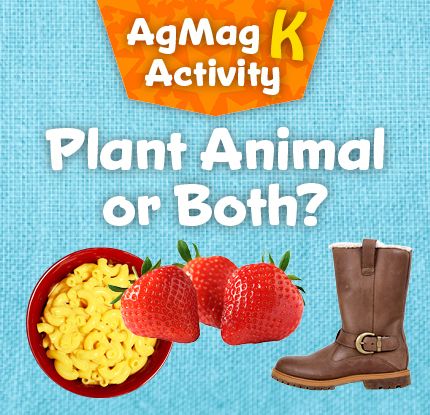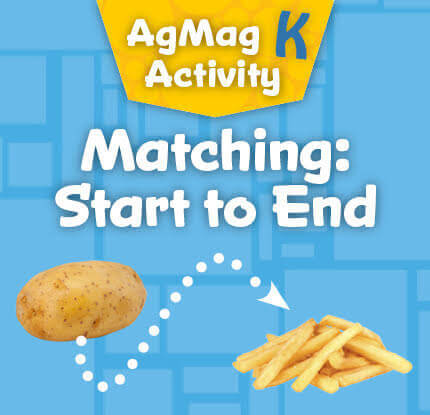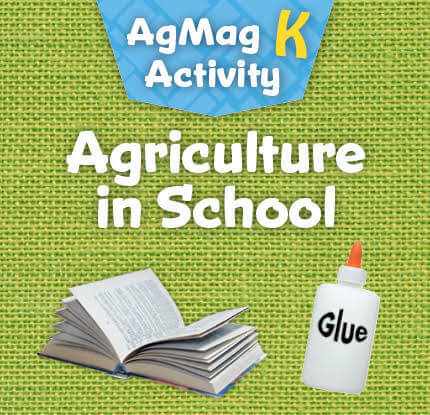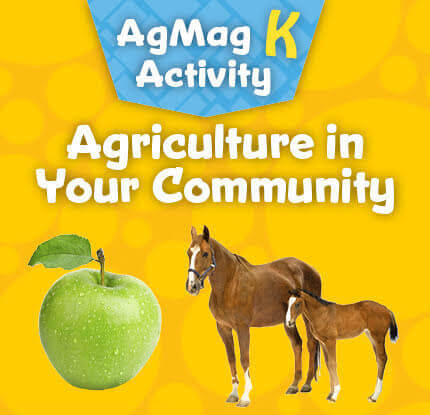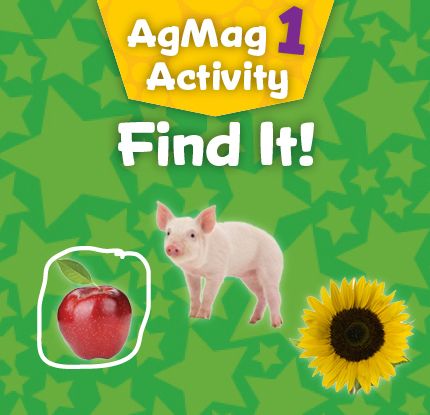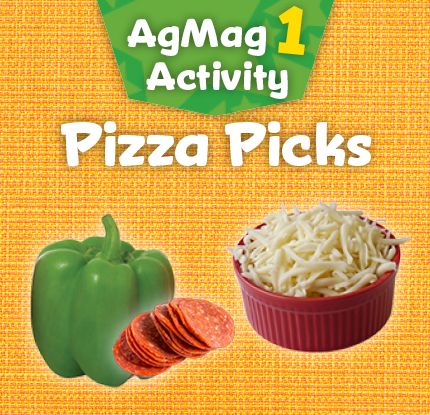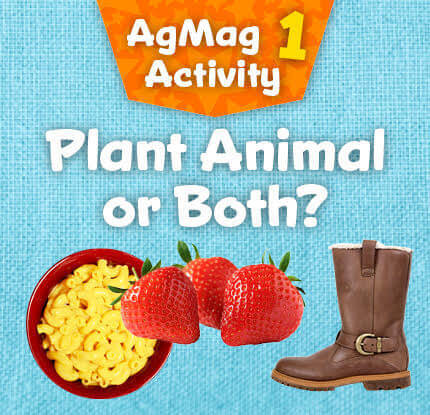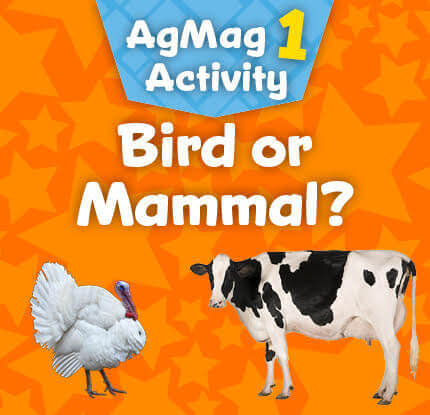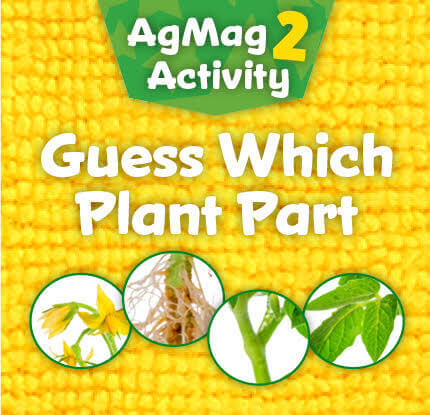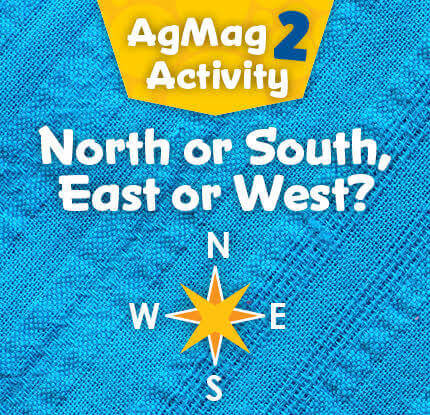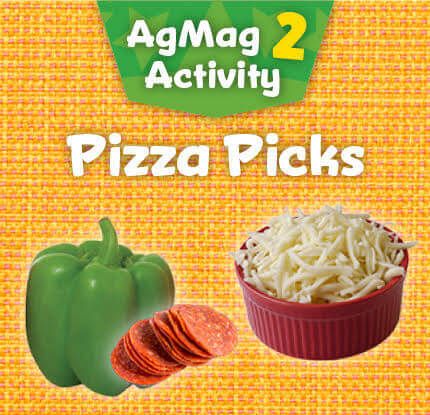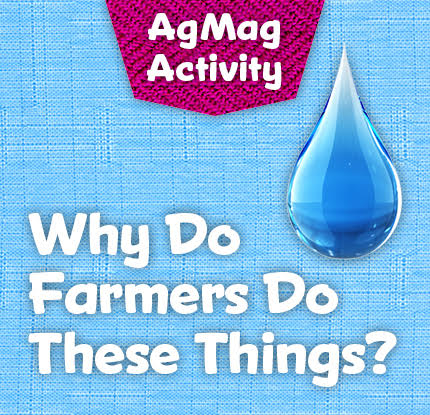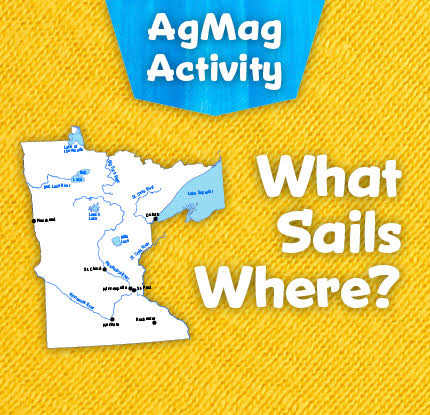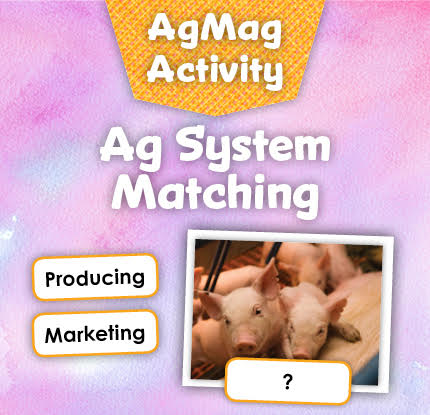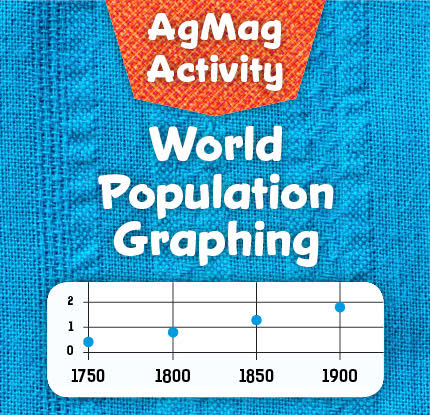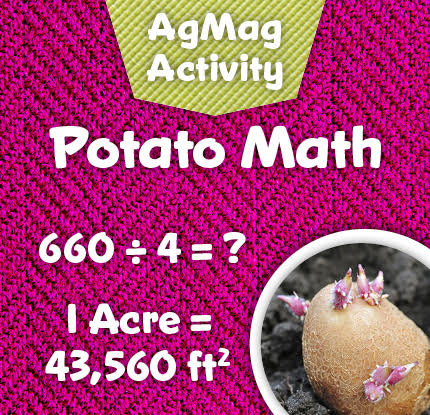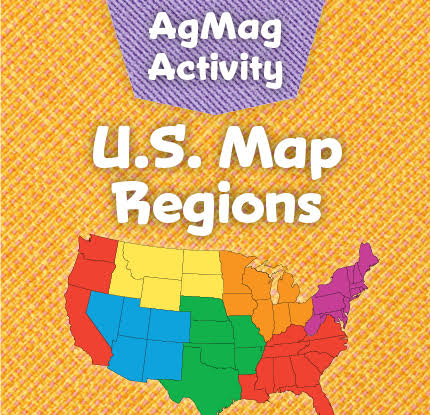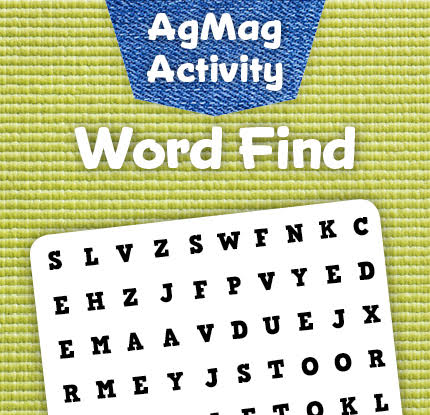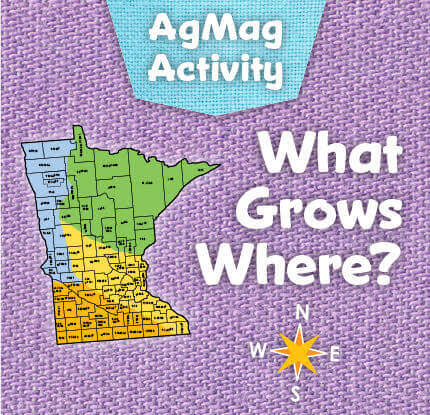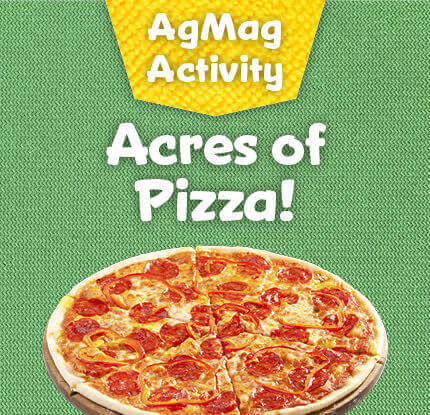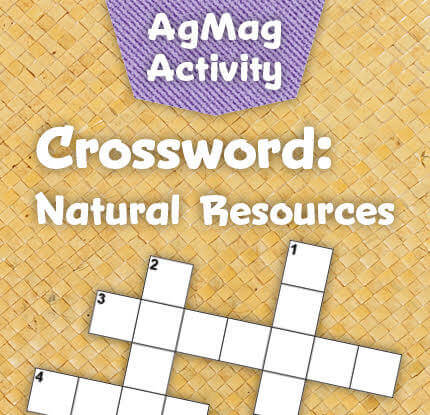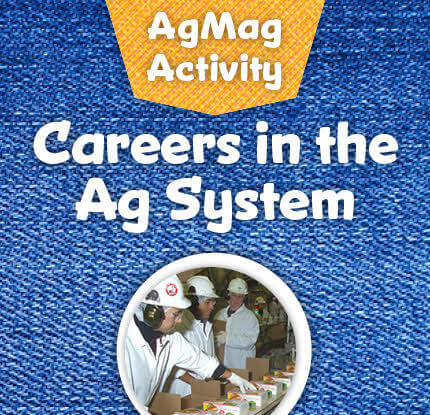AgMag Grade 2 Teachers Guide
Started in 1985, the Minnesota Agriculture in the Classroom program (MAITC), is a unique public/private partnership between the Minnesota Department of Agriculture and the MAITC Foundation. The program goal is to advance agricultural literacy to all learners, especially K-12 students and educators. MAITC’s mission is “to promote understanding and awareness of the importance of agriculture.”
We are pleased to offer the free AgMag series for kindergarten, first, and second grades (AgMag K, AgMag 1, and AgMag 2). Each issue is written and targeted to each specific grade level from K-2 (for 4th - 6th grade students, MAITC offers a separate publication called simply AgMag). The magazine is sent early in the school year for beginning readers. Teachers can use it when the reading level of their students matches the reading level of the magazine. We publish two issues each school year, in October and March. Enjoy!
The AgMag2 series is made possible due to the generous financial support of Compeer Financial Services, a long-time supporter of the MAITC education program.
Why Ag in the Classroom?
Previously, people were very aware of the role agriculture played in their lives—it meant survival. Nearly everyone—men, women, and children—worked the land.
Agriculture still means survival. That will never change. But as time goes on, fewer people have close contact with farming. They’re not aware of their own—and the nation’s—total dependence on agriculture. Think about it:
- Fewer than 2 out of 100 Americans work directly in production agriculture (farming). This small group meets the food and fiber needs of the nation as well as many people abroad.
- Agriculture, along with its related occupations, is the nation’s largest industry. It generates billions of dollars each year; one out of every five jobs depends on it in some way.
Agriculture is constantly changing. But one thing remains the same: Agriculture is a vital part of your day! Even as early as the primary grades, it’s important for students to gain an understanding and appreciation for the ways agriculture touches their lives, each and every day. Food doesn’t magically appear in the grocery store or on the kitchen table. It all starts with agriculture.
Minnesota Academic Standards Connection
|
Subject |
Standard Code |
Benchmark |
|
Social Studies |
3.3.1.1.2 |
Locate key features on a map or globe; use cardinal directions to describe the relationship between two or more features. |
|
Science |
2.4.1.1.1 |
Describe and sort plants into groups in many ways, according to their physical characteristics and behaviors. |
|
Science |
2.4.3.1.1 |
Recognize that plants need space, water, nutrients and air and that they fulfill these needs in different ways. |
|
English Language Arts |
2.2.1.1 |
Ask and answer such questions as who, what, where, when, why and how, to demonstration understanding of key details in a text. |
GLOSSARY
AGRICULTURE: Growing plants and raising animals that people use for food, clothing, and many other things every day. It’s also harvesting those farm products and getting them to us so we can use them. Agriculture is the industry that grows, harvests, processes, and brings us food, fiber, fish, forests, sod, landscaping materials, and more. It uses soil, water, sun, and air to produce its products. The process starts on farms, orchards, gardens, and ranches with the growing and the harvesting of crops and livestock, then moves to processing plants before finally traveling as finished products to stores, farm markets, lumberyards, greenhouses, and more where consumers buy the products. Agriculture is connected in some way with almost everything we eat, wear, and use. Quote from an Unknown Source: “Agriculture is not simply farming. It’s the supermarket, the equipment factory, the trucking system, the overseas shipping industry, the scientist’s laboratory, the houses we live in, and much more. It affects the air we breathe, the ground we walk on, the water we drink, and the food we eat.”
CROPS: Plants which are grown and harvested to feed people and animals or to make other things people need.
FARM: Areas of land where plants and animals are grown or raised for food, clothing, and more.
FARMER: A person who lives and works on a farm (also called producers). Farming is a career; farmers make money by selling their farm products.
FARM (Agriculture) PRODUCTS: Animals or plants raised on farms, or products made from them. Raw materials often must be changed (processed) to be of use. Example: Sheep are sheared to produce wool, but a hunk of raw wool has no practical purpose to someone who needs clothes. The wool is cleaned and processed into yarn, fabric, and eventually clothing, which are woolen products people can use.
AgMag 2 Cover—Agriculture is Everywhere!
(See Agriculture in the Glossary. The goal of the first two pages of your AgMag 1 is to define agriculture and guide students to think about how many things in their everyday world are connected to agriculture.)
Discussion Prompters
1. What is agriculture? (Invite students to offer their own definitions. Some may say “farming” or “milking cows.” Agriculture starts on the farm, but includes all the people and places which harvest the farm crops, change them into forms we can use and get them to stores where we can buy them. It is all the businesses and workers who get food, clothing, furniture, landscaping trees, lumber, and more from the farms to our homes, schools, and communities.)
2. Who were the first farmers? (Many years ago, Native Americans lived on the land where we live today. They hunted deer, buffalo, and small animals in the forest. They raised crops (corn, squash, and beans) and harvested nature’s crops (berries, nuts, maple syrup, wild rice). All their food, homes, clothing, weapons, and toys came from the land and water. Many of the foods we eat at Thanksgiving and year-round are thanks to Native Americans.)
3. How has the job of the farmer become easier today than it was long ago? (Modern machinery has replaced horse or oxen power and old-fashioned tools. Scientists have developed plants that can grow in many different weather and soil conditions. Animal nutritionists and veterinarians help keep farm animals healthy.)
4. Do you know someone whose job is connected to agriculture? How?
5. Some students may need help connecting items at the bottom of the page back to their plant and animal sources. Discuss as a class, then invite them to mark “P” by the items that come from plants and “A” by the items that come from animals.
6. Ask students to look around the classroom. What things in the room might come from agriculture, and what source of agriculture did they come from? Examples might include pencils made from wood (trees), soles of tennis shoes (rubber), or items of clothing (wool or cotton).
7. Look at the six items pictured on the first page. Where did they come from?
Answers: pajamas and bedding (cotton); school bus tires (plants and animal fats); jacket (wool from sheep); pancakes, cereal, and milk (wheat and other grains, dairy cows); soap (may have many different ingredients including soy and other vegetable oils, fats from cattle, scent oils like almond, coconut or mint, honey, beeswax, wheat germ, oatmeal, and lanolin from sheep). Challenge your students to think of additional ways that they have used agriculture during their morning
routine and also their time at school.
Activity
Page 2—Plant Power
Discussion Prompters
Plants are an important part of agriculture. The kinds of plants included under the term “agriculture” may be wider than many students understand. Besides things like corn, soybeans, and apples, there are things like cotton plants (clothing), flowers (decoration), sod (lawns), aloe plants and ginseng (health and wellness products), and trees (buildings, paper, and syrup). Ask the students how many kinds of plants they can name that are part of agriculture.
1. Explain some of the other kinds, as described above.
2. Why are plants important? (They provide needed nutrition for humans and animals, important for the air we breathe, nourish soil and prevent erosion, used for shelter by animals)
One example of how plants nourish soil is “green manure.” Explain this to the students: Manure is animal waste. It has nutrients that help crops grow better. But there’s also a plant version of manure called green manure. Crops like clover and rye are planted and grow in farm fields. Once they’re grown, they’re plowed back into the soil. These crops put nutrients into the soil that help crops grow better, like animal manure.
Cover crops are used to prevent soil erosion. Often the cover crop is planted after the main crop is harvested, and the cover crop grows during the off season so the soil is nourished for the following cash crop season. Cover crops also deter weeds, control disease and pests, and contribute to the soil’s nourishment.
Activity: How do we use plants?
Answers:
Cotton plant = clothing
Flowers (tulips, germaniums, flowering shrubs, etc.) = decoration
Aloe plant, ginseng = health and wellness
Trees = buildings, paper, and syrup
Strawberries = food
Page 3—Plants Have Many Parts
Discussion Prompters
This page shows the different parts plants can have. Discuss what role each part plays.
Stems: Most stems grow above ground and produce branches, leaves, flowers, and fruit. There are some
plants that produce stems below the ground, such as the potato. Stems also bring nutrients and water
from the roots to the rest of the plant.
Flowers: Flowers can be the beginning of the fruit. They're the point at which pollination takes place,
which allows the plant to produce seeds and sometimes a fruit which holds the seeds.
Leaves: Leaves turn sunlight into food through photosynthesis.
Roots: The lower part of the plant. While this usually occurs under the ground, there are some plants
that have roots that grow above the ground (examples include: orchids and spider plants). The roots
anchor the plant to help keep it from being uprooted by wind or rain, and they also help provide
nourishment to the plant by absorbing water and nutrient from the soil. Some vegetables grow
underground and are known as root vegetables, like beets and carrots.
Fruit: The part of a plant that has seeds in it, making the growth cycle a circle.
Seeds: The beginning of a plant. Seeds carry the initial nutrients needed for the plant to grow. When the
seed sprouts, roots form to start growing the plant.
Note: If you want to add some reading to this part, the book Tops and Bottoms by Janet Stevens is a
humorous, age-appropriate book to help reinforce concepts of plant parts.
Activity:
Have students write the correct name of each plant part next to its description.
Answer Key
- Stems
- Roots
- Seeds
- Fruit
- Flowers
- Leaves
Page 4—What Plants Need to Grow
One way to frame this topic is in terms of similarities and differences between humans and plants.
- Plants need air, water, and sunlight to grow. Humans need those things too.
- Neither plants nor humans can survive long without water.
- Plants use sunlight to help them make sugar and starches. Humans need sunlight for Vitamin D, which helps build strong bones and to fight off bacteria and viruses, among other things.
- Plants take carbon dioxide out of air and use it to make the sugars and starches the plant uses
for food. Because too much carbon dioxide is bad for humans, it’s good that plants need and use
it.
Plant Challenge:
Discuss whether or not plants need air, water, and light to grow. Then ask students what they could do to test this idea. If feasible, try planting four plants of the same type. Make sure one has plenty of air, water, and light. Then take each of the others and deprive it of one of those things. Have the students monitor over several days and write up their learnings.
Page 5—Winter Growing
Discussion Prompters:
Explain that different types of crops need different amounts of time to grow and be ready to eat. Some things, like lettuce and radishes, can grow very quickly. But other things, like carrots, can take much longer, which is why they’re traditionally planted in the spring for harvest in late summer or fall. Students in New Ulm wanted to see what it would take to grow carrots that they could eat in early spring instead.
What Would You Do?
After reading about the New Ulm students who grew carrots over the winter, have the students discuss what it would take to do that in your classroom.
If you’re interested in testing the idea out, here is part of the lesson plan that Beth Sletta, the New Ulm teacher, developed for her classroom (shared with her permission):
Winter Sowing
In this cross-curricular lesson, students will investigate cold hardy seeds and plant them in containers as they attempt to solve the problem of a lack of produce to harvest from the garden before summer break. Students will collaborate as they design planting containers to be placed outside during late winter months. Students will practice collecting accurate data using measurement tools. Students will observe how sun, soil, water, and weather affect germination and plant growth. Time: Two 45-minute lessons in fall, two 60-minute lessons during the late winter, and one 30-minute lesson during spring. Short periods of time for data collection will also be required.
Materials List:
- The Carrot Seed - book by Ruth Krauss
- Simple garden tools
- Garden plot or low-sided large tote
- Soil
- Seed packet worksheet (at end of lesson)
- Planning template worksheet (at end of lesson)
- Recording sheet (at end of lesson)
- Carrot seeds in packets (or other vegetable usually grown over the summer, making sure they’re
cold tolerant) - Variety of clear plastic containers such as gallon or half gallon milk jugs or 2-liter soda bottles
- Drill or hammer and nail
- Knife for teacher use
- Potting soil
- Duct Tape
- Permanent markers
- Data recording sheets for plant growth and pencils
- Class journal for weather observations
- Outdoor thermometer and rain gauge
- Clear plastic cups to cover plants in case of snow
Instructor Procedure:
Fall months - 45 minutes
To stimulate interest, ask students if they think they can plant carrots or other seeds in the winter so they can reap the harvest before school dismisses for summer break.
- Read The Carrot Seed, a lesson in perseverance.
- As you read, have students act out the activities related to planting a seed. Discuss and show simple machines used when digging with shovel, planting seeds, pulling weeds, and pushing a wheelbarrow (garden shovel, trowel, wheelbarrow, etc.).
- Help students connect the problem of the people not believing the little boy in The Carrot Seed to people wanting to plant seeds in winter.
- Discuss the character trait of perseverance and allow students to brainstorm solutions to this problem of harvesting produce earlier in the spring.
- Watch Science Farm - My Carrot Diary video to learn about carrot farmers and to review what seeds need in order to germinate. Continue class discussion about whether students think seeds sown in winter will grow.
Activity 2 - Plant Hardiness Zone Maps and Winter Tolerant Seeds - 60 minutes
- As a class, create a chart showing cold-tolerant seeds and seeds that are not cold tolerant.
- Hand out seed packets to groups of students and have them complete the seed packet worksheet together to determine if their seeds are cold tolerant and can be used for winter sowing.
- Watch video about seed packets which demonstrates how to read a seed packet.
- Introduce USDA Plant Hardiness Zone map and locate zone where students live. Print map of Minnesota, mark school’s location, and color and label hardiness zones. Explain how the USDA plant hardiness zone map helps gardeners and farmers know what types of seeds to plant. Show a seed packet that lists the hardiness zone.
- Explain to the class that they are going to follow the lead of the New Ulm students and plant these cold-tolerant seeds outdoors in late winter.
Activity 3 - Designing and engineering containers for winter sowing - 60 minutes
- Provide students with planning template and a materials list to design their own winter sowing containers.
- Invite adult volunteers to help students create their winter sowing containers following directions in video, book, and student designs. **Only adults should use the knife to cut jugs. Jugs could be cut previous to class to save time.
- Plant cold-tolerant seeds, as determined by seed packet research, in winter sowing containers.
- Place jugs outside in area that will receive precipitation and sun, making sure they are labeled well.
Recording Periods - Throughout the winter months
- At various times throughout the winter months students should check winter sowing containers to collect data and record on recording sheets.
Activity 4 - Transplanting Seedlings - Spring months - 30 minutes
When seedlings are strong enough to move and the temperatures are consistently above freezing, it is time to transplant the seedlings from the winter sowing containers to the garden beds.
- Help students dig holes in the garden plots. These holes must be large enough for the seedlings that have been growing in the winter sowing containers. Some seedlings can be planted in beds where winter rye was grown and tilled under to improve soil. Other seedlings will be planted in beds without the benefit of rye. Additional observations could be made comparing growth in the two beds.
- Demonstrate how to gently remove the seedling and the entire root system to transplant.
- Students should continue to observe and record plant growth during the spring months.
- Students could directly sow seeds of the same type next to the transplanted seedlings to compare growth.
- If snow is predicted, you may need to cover plants with clear cups or cloches.
Closure and Reflection
Each zone will differ, but in Minnesota, zone 4B, cold-tolerant plants such as beets, kale, spinach, leeks, onions, lettuce, and radishes should grow enough to harvest before summer break. Celebrate with students as they harvest produce grown from seeds planted in winter.
Templates to use for this lesson:
Reading a seed packet
Planning template for winter sowing containers
Recording sheet for plant growth
Seed Packet Math
Have students calculate how long it would take carrots to grow if planted on both March 1 and May 7. The seed package notes that it takes 60 days to mature. Suggest to the students that they use a calendar to help count the days from planting to eating.
March 1: April 30
May 7: July 6
Page 6—Minnesota
Explain to the students that weather and soil vary across the state. The southern part of the state has a longer growing season than the north, which often experiences a longer winter. The northeast soil is not as conducive to growing crops like wheat and sugarbeets as the more fertile areas along the Red River on the western side of the state.
Color the Direction answers
- Wheat: West
- Cows: East
- Pigs: South
- Corn: South
- Trees: North
Map It answers
Students may need help with questions 1 and 2.
Answers:
- Coldest: North
- Warmest: South
AgMag is a publication of Minnesota Agriculture in the Classroom (MAITC). The program is a public/private partnership between the Minnesota Department of Agriculture and the Minnesota Agriculture in the Classroom Foundation. This publication is made possible with special funding from Compeer Financial. MAITC Program Staff: Keri Sidle and Sue Knott. Writer and Editor: Amy Rea. Creative Direction, Design and Production: Solberg Creative, LLC. Educational Consultants: Amy Wills and Jackie McCormick.
Learn about and order our free educational materials at http://mn.agclassroom.org.
- AgMag 2 Fall 2019 Teacher Guide PDF
- AgMag 2 Fall 2019 Quiz Questions
- AgMag 2 Fall 2019 Quiz Questions and Answers
- (Worksheet) Reading a Seed Packet
- (Worksheet) Sowing Planning Guide
- (Worksheet) Plant Observation Sheet
